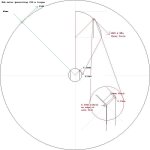Update: Math corrected. I'd made several mistakes, but the upshot is that once corrected, it makes the point even more strongly.
(Why did I my errors earlier? My excuse it that it is the adversarial nature of this place, and certain member's predilection for using pedantry to score cheap 'points' rather than engage, has made my first reaction to criticism, hostility. If those that noticed the errors, posted clear descriptions of them rather than veiled allusions to them, those criticisms would be accepted. If they posted corrections, that would be even better. That, and it's been 20 years since I used this stuff on a regular basis, so its rusty. )
Aluminium strain hardens. As it deforms and rebounds within its elastic limits during use, the microstructure of the metal changes and it becomes more brittle over time.
Assume a fairly ordinary DD hub producing say 20Nm torque acting at the 80mm air gap radius means 250N of force. With a M14 axle with 10mm across the flats, the edges of the flats are acting on the thickness of the torque plate(s) at a distance of 7.21mm; magnifying that force to to 2774 N.
If the edge of the axle flat has a radius (many don't) of 0.25mm, and the plate is 10mm (3/8th" thick), with 2774N of force acting on a 0.01m x 0.00025m area, you have 1109.6 MPa of shear force. And that is steady state.
The shock loading from accelerating, braking and dropping off curbs can 5-20 times higher.
With Al 6061-T6 having a yield strength of 241 MPa when new, 10mm thick torque plates are barely adequate at best,
if the bearing surface is a 10mm x 0.25mm flat area.
Now consider that a M14 course thread with a 2mm pitch would have at most 6 thread points of 2mm/8 width in contact.
That reduces the bearing surface to 6 x 0.00025m x 0.0005mm, and the shear force has climbed to 3,698 MPa steady state.
Yes, as the threads dig in the bearing surface area will increase, but by then, the 5 or 6 point contacts have created
a line of stress risers across the thickness face of the TP.
From the side, there will be no visible sign of a problem. Any small signs of deformation will be covered by the nut.
Internally, that line of stress points will have set up the start of slip fractures in the grain structure, and every time you brake, accelerate, hit minor road imperfections, the lattice dislocations along the slip plane ahead of any plastic deformation grows as the strain-hardened embrittlement spreads.
Eventually, the sharp edge of the axle flat, armed with its serrated teeth, will slice through the embrittled plate like an apple corer.

(Why did I my errors earlier? My excuse it that it is the adversarial nature of this place, and certain member's predilection for using pedantry to score cheap 'points' rather than engage, has made my first reaction to criticism, hostility. If those that noticed the errors, posted clear descriptions of them rather than veiled allusions to them, those criticisms would be accepted. If they posted corrections, that would be even better. That, and it's been 20 years since I used this stuff on a regular basis, so its rusty. )
Aluminium strain hardens. As it deforms and rebounds within its elastic limits during use, the microstructure of the metal changes and it becomes more brittle over time.
Assume a fairly ordinary DD hub producing say 20Nm torque acting at the 80mm air gap radius means 250N of force. With a M14 axle with 10mm across the flats, the edges of the flats are acting on the thickness of the torque plate(s) at a distance of 7.21mm; magnifying that force to to 2774 N.
If the edge of the axle flat has a radius (many don't) of 0.25mm, and the plate is 10mm (3/8th" thick), with 2774N of force acting on a 0.01m x 0.00025m area, you have 1109.6 MPa of shear force. And that is steady state.
The shock loading from accelerating, braking and dropping off curbs can 5-20 times higher.
With Al 6061-T6 having a yield strength of 241 MPa when new, 10mm thick torque plates are barely adequate at best,
if the bearing surface is a 10mm x 0.25mm flat area.
Now consider that a M14 course thread with a 2mm pitch would have at most 6 thread points of 2mm/8 width in contact.
That reduces the bearing surface to 6 x 0.00025m x 0.0005mm, and the shear force has climbed to 3,698 MPa steady state.
Yes, as the threads dig in the bearing surface area will increase, but by then, the 5 or 6 point contacts have created
a line of stress risers across the thickness face of the TP.
From the side, there will be no visible sign of a problem. Any small signs of deformation will be covered by the nut.
Internally, that line of stress points will have set up the start of slip fractures in the grain structure, and every time you brake, accelerate, hit minor road imperfections, the lattice dislocations along the slip plane ahead of any plastic deformation grows as the strain-hardened embrittlement spreads.
Eventually, the sharp edge of the axle flat, armed with its serrated teeth, will slice through the embrittled plate like an apple corer.





